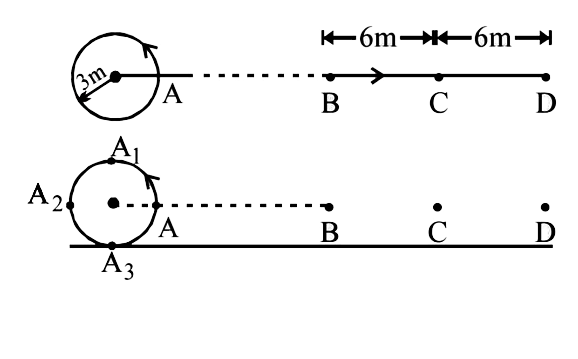Two sound waves of frequencies 100Hz and 102Hz and having same amplitude 'A' are interfering. At a stationary detector, which can detect resultant amplitude greater than or equal to A. So, in a given time interval of 12 seconds, finds the total duration in which detector is active.
The correct Answer is:8
Step by step video & image solution for Two sound waves of frequencies 100Hz and 102Hz and having same amplitude 'A' are interfering. At a stationary detector, which can detect resultant amplitude greater than or equal to A. So, in a given time interval of 12 seconds, finds the total duration in which detector is active. by Physics experts to help you in doubts & scoring excellent marks in Class 12 exams.
Updated on:21/07/2023Topper's Solved these Questions
- WAVE MOTIONBOOK - AAKASH SERIESCHAPTER - WAVE MOTIONEXERCISE - PRACTICE SET (EXERCISE-VI (LEVEL-I(MAIN) STRAIGHT OBJECTIVE TYPE QUESTIONS))
10 Videos
- WAVE MOTIONBOOK - AAKASH SERIESCHAPTER - WAVE MOTIONEXERCISE - PRACTICE SET (EXERCISE-VI (LEVEL-II(ADVANCED) STRAIGHT OBJECTIVE TYPE QUESTIONS))
9 Videos
- WAVE MOTIONBOOK - AAKASH SERIESCHAPTER - WAVE MOTIONEXERCISE - PRACTICE SET (EXERCISE-V (LEVEL-II(ADVANCED) MATRIX MATCHING TYPE QUESTIONS))
1 Videos
- UNITS AND MEASUREMENTSBOOK - AAKASH SERIESCHAPTER - UNITS AND MEASUREMENTSEXERCISE - EXERCISE -3
66 Videos
- WAVE MOTION AND SOUNDBOOK - AAKASH SERIESCHAPTER - WAVE MOTION AND SOUNDEXERCISE - PROBLEMS (LEVEL - II)
97 Videos
Similar Questions
Two sound waves travelling in the same direction are superposed. Their frequencies are 300and302Hz and their amplitudes are 0.2and0.3mm, respectively
a. What is the number of beats per second ?
b. What are the maximum and minimum values of resultant amplitude during the formation of beats ?
c. Calculate the ratio of maximum and minimum intensities of the resultant sound.
View SolutionThe planes sources of sound of frequency n1=400Hz,n2=401Hz of equal amplitude of a each, are sounded together. A detector receives waves from the two sources simultaneously. It can detect signals of amplitude with magnitude ≥ a only,
View SolutionA soure of sound of frequency 165 hz is placed in front of a wall at a distance 2 m from it. A dtector is also placed in front of the wall at the same distance from it. Find the minimum distance between the source and detector for which maximum sound is recorded int he detector . the speed of sound is 330 m/s
View SolutionA whistle of frequency f0 = 1300 Hz is dropped from a height H = 505 m above the ground. At the same time, a detector is projected upwards with velocity v=50ms−1 along the same line. If the velocity of sound is c=300ms−1 find the frequency detected by the detector after t = 5s.
View SolutionTwo small loudspeakers A,B ( 1m apart) are connected to the same oscillator so that both emit sound waves of frequency 1700Hz in phase . A sensitive detector , detects a maximum wave at P on the perpendicular bisector MPofAB and another maximum wave when it first reaches a point Q directly opposite to B. Calculate the speed c of the sound waves in air .

View SolutionTwo waves, each having a frequency of 100 Hz and a wavelength of 2.0 cm, are travelling in the same direction on a string. What is the phase difference between the waves if the second wave was produced 0.015 s later than the first one at the same place,
View SolutionA source of sound is moving along a circular orbit of radius 3meter with an angular velocity of 10rad/s. A sound detector located far away from the source is executing linear simple harmonic motion along the line BD with an amplitude BC=CD=6meters. The frequency of oscillation of the detector is 5π per second. The source is at the point A when the detector is at the point B. If the source emits a continuous sound wave of frequency 340Hz, Find the maximum and the minimum frequencies recorded by the detector.

View SolutionA diode detector is used to detect and amplitude modulated wave of 60% modulation by using a condenser of capacity 250 pF in parallel with a load resistance 100kΩ. Find the maximum modulated frequency which could be detected by it
View SolutionTwo waves, each having a frequency of 100 Hz and a wavelength of 2.0 cm, are travelling in the same direction on a string. What is the phase difference between the waves (a) if the second wave was produced 0.015 s later than the first one at the same place, (b) if the two waves were produced at the same instant but the first one was produced a distance 4.0 cm behind the second one ? (c) If each of the waves has an amplitude of 2.0 mm, what would be the amplitudes of the resultant waves in part (a) and (b) ?
View SolutionA sound source S, emitting a sound of frequency 400 Hz and a receiver R of mass m are at the same point. R is performing SHM with the help of a spring of force constant K. At a time t = 0, R is at the mean position and moving towards the right, as shown. At the same time, the source starts moving away from R with some acceleration a. The frequency registered by the receiver at a time t = 10 s is 250 Hz. What is the time (in seconds) at which the corresponding registered frequency of 250 Hz was emitted by the source? [Given that mK=25π2 and amplitude of oscillation = 100πm,Vsound = 320 m s^(-1)]

View Solution
